Paul Revere
Paul Revere (January 1, 1735 – May 10, 1818) was the son of Apollos Rivoire, a French Huguenot (Protestant) immigrant, and Deborah Hichborn, daughter of a local artisan family. Rivoire, who changed his name to Paul Revere after immigrating, was a goldsmith and eventually the head of a large household. Paul Revere was the second of at least 9, possibly as many as 12 children and the eldest surviving son.
Revere was educated at the North Writing School and learned the art of gold and silversmithing from his father. When Paul was 19, and nearly finished with his apprenticeship, his father died, leaving Paul as the family’s main source of income. Two years later, in 1756, Revere volunteered to fight the French at Lake George, New York, where he was commissioned as a second lieutenant in the colonial artillery.
In August, 1757, Revere married Sarah Orne. Together, they had eight children. Soon after Sarah’s death in 1773, Revere married Rachel Walker with whom he had eight children.
Revere’s primary vocation was that of goldsmith/silversmith, meaning he worked in both gold and silver. He learned the trade from his father, and his silvershop was the cornerstone of his professional life for more than 40 years. As the master of his silversmith shop, Revere was responsible for both the workmanship and the quality of the metal alloy used. He employed numerous apprentices and journeymen to produce pieces ranging from simple spoons to magnificent full tea sets. His work, highly praised during his lifetime, is regarded as one of the outstanding achievements in American decorative arts.
Revere also supplemented his income with other work. During the economic depression before the Revolution, Revere began his work as a copper plate engraver. He produced illustrations for books and magazines, business cards, political cartoons, bookplates, a song book and bills of fare for taverns.
He also advertised as a dentist from 1768 to 1775. He not only cleaned teeth, but also wired in false teeth carved from walrus ivory or animal teeth. Contrary to popular myth, he did not make George Washington’s false teeth. Fabricating a full set of dentures was beyond his ability.
Source: paulreverehouse.org
More Fascinating Facts for Paul Revere
Where is the Liberty Tree?
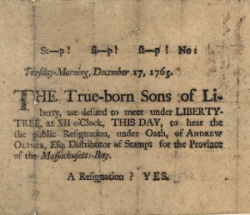 August 14, 1765 — Today, American patriots protested against the British rule in response to the Stamp Act, which forced colonists to pay taxes on paper products in order for Britain to pay off its huge debt from the French and Indian War.
August 14, 1765 — Today, American patriots protested against the British rule in response to the Stamp Act, which forced colonists to pay taxes on paper products in order for Britain to pay off its huge debt from the French and Indian War.
Outraged activists — known as the Sons of Liberty — protested shouting, “no taxation without representation.” They included John Adams, Paul Revere and Samuel Adams. The location of their demonstration was near an Elm tree that stood in Boston Common, Massachusetts. Today, it is known as the Liberty Tree.
John Adams was quoted about the event in the Boston Gazette, saying: “The Sons of Liberty on the 14th of August 1765, a Day which ought to be for ever remembered in America, animated with a zeal for their country then upon the brink of destruction, and resolved, at once to save her…”
What 16-year-old rode from NY to CT today to rally her father’s militia?
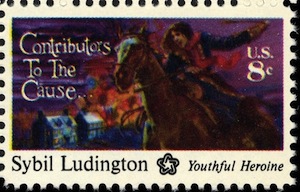 April 26, 1777 — Sybil Ludington, 16, rode from New York to Connecticut tonight, rallying her father’s militia. Her heroic ride took her twice the distance of Paul Revere’s.
April 26, 1777 — Sybil Ludington, 16, rode from New York to Connecticut tonight, rallying her father’s militia. Her heroic ride took her twice the distance of Paul Revere’s.
The eldest of 12 children, Sybil’s father was Colonel Henry Ludington, commander of the 7th Regiment of the Dutchess County Militia during the American Revolutionary War. He oversaw a regional network of anti-Tory spies.
Earlier in the day, Col. Ludington received word that the British had landed in Long Island Sound and were planning to attack Danbury, CT — a town vital for its strategic location and its storehouse of revolutionary armaments. Needing to rouse the volunteers under his command, Ludington was faced with a dilemma — he could not make the ride himself, as he needed to remain at his home to organize the rallying defense, but the horseman who had alerted him was too weary from his journey to continue.
According to legend, the Colonel turned to his daughter, who was barely 16 at the time, and asked her to make the ride. Through the rainy night on unlit, muddy trails, she is said to have ridden 40 miles to the towns of Carmel, Mahopac, and Stormville, conveying word to the soldiers to gather at her father’s house at daybreak. The troops were rallied, but too late — much of Danbury was burned by the British, though the American militia was able to block the King’s men from advancing into New York.
The story of Sybil Ludington’s ride has been compared to the heroics of Paul Revere two years earlier, with two key distinction — Ludington’s ride was more than twice the distance of Revere’s, and Revere was a trained military officer while Ludington was a teenage girl whose assignment came as a complete surprise.
Markers have been erected along the route she is believed to have traveled, but historians have questioned the veracity of these events, since no mention of her ride appeared in print during her lifetime. Her purported heroism was first described in a biography of her father, which was published in 1907 by two of his grandchildren. Her nephew Harrison Ludington (1812-1891) was elected Mayor of Milwaukee and Governor of Wisconsin in the 1870s.
What famous silversmith and hero of the Revolutionary War died today?
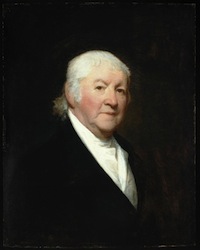 May 10, 1818 — Paul Revere died today.
May 10, 1818 — Paul Revere died today.
Born January 1, 1735 to Apollos Rivoire, a French Huguenot (Protestant) immigrant, and Deborah Hichborn, daughter of a local artisan family — he changed his name to Paul Revere after immigrating, was a goldsmith and eventually the head of a large household. He was the second of at least 9, possibly as many as 12 children and the eldest surviving son.
Revere was educated at the North Writing School and learned the art of gold and silversmithing from his father. When Paul was nineteen (and nearly finished with his apprenticeship) his father died, leaving Paul as the family’s main source of income. Two years later, in 1756, Revere volunteered to fight the French at Lake George, New York, where he was commissioned as a second lieutenant in the colonial artillery.
In August, 1757, Revere married Sarah Orne. Together, they had eight children. Soon after Sarah’s death in 1773, Revere married Rachel Walker with whom he had eight children.
Revere’s primary vocation was that of goldsmith/silversmith, meaning he worked in both gold and silver. He learned the trade from his father, and his silvershop was the cornerstone of his professional life for more than 40 years. As the master of his silversmith shop, Revere was responsible for both the workmanship and the quality of the metal alloy used. He employed numerous apprentices and journeymen to produce pieces ranging from simple spoons to magnificent full tea sets. His work, highly praised during his lifetime, is regarded as one of the outstanding achievements in American decorative arts.
Revere also supplemented his income with other work. During the economic depression before the Revolution, Revere began his work as a copper plate engraver. He produced illustrations for books and magazines, business cards, political cartoons, bookplates, a song book and bills of fare for taverns. He also advertised as a dentist from 1768 to 1775. He not only cleaned teeth, but also wired in false teeth carved from walrus ivory or animal teeth. Contrary to popular myth, he did not make George Washington’s false teeth. Fabricating a full set of dentures was beyond his ability.
Which famous silversmith and hero of the Revolutionary War was born today?
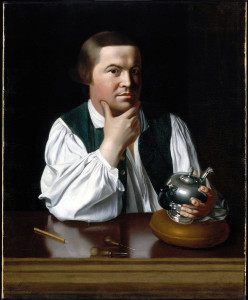 January 1, 1735 —
January 1, 1735 —
Paul Revere was born today. He was the son of Apollos Rivoire, a French Huguenot (Protestant) immigrant, and Deborah Hichborn, daughter of a local artisan family; Apollos changed his name to Paul Revere after immigrating.
His eldest son, Paul, who became famous for both his craftsmanship and his midnight ride, was educated at the North Writing School and learned the art of gold and silversmithing from his father. When Paul was 19 (and nearly finished with his apprenticeship) his father died, leaving Paul as the family’s main source of income. Two years later, in 1756, Revere volunteered to fight the French at Lake George, NY, where he was commissioned as a second lieutenant in the colonial artillery.
In August, 1757, Revere married Sarah Orne. Together, they had eight children. Soon after Sarah’s death in 1773, Revere married Rachel Walker with whom he had eight children.
His primary vocation was goldsmith/silversmith, a trade he learned from his father. His silvershop was the cornerstone of his professional life for more than 40 years, and he was responsible for the workmanship and quality of the metal alloy that was used. He employed numerous apprentices and journeymen to produce pieces ranging from simple spoons to magnificent full tea sets. His work, highly praised during his lifetime, is regarded as one of the outstanding achievements in American decorative arts.
Revere also supplemented his income with other work. During the economic depression before the American Revolution, Revere also began working as a copper plate engraver. He produced illustrations for books and magazines, business cards, political cartoons, bookplates, a song book, and bills of fare for taverns. He also advertised as a dentist from 1768 to 1775, who cleaned teeth and wired in false teeth carved from walrus ivory or animal teeth. Contrary to popular myth, he did not make George Washington’s dentures. Fabricating a full set was beyond his expertise.
Paul Revere died on May 10, 1818.
What was the route of what historians consider the most infamous midnight ride in the Revolutionary War?
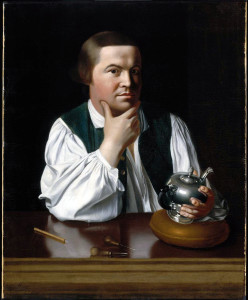 April 18, 1775 — Today in history, Paul Revere rode from Charleston to Lexington warning the “regulars are coming!”
April 18, 1775 — Today in history, Paul Revere rode from Charleston to Lexington warning the “regulars are coming!”
Revere was sent by Dr. Joseph Warren, who instructed him to ride to Lexington, Massachusetts, to warn Samuel Adams and John Hancock that British troops were marching to arrest them.
After being rowed across the Charles River to Charlestown by two associates, Revere borrowed a horse from his friend Deacon John Larkin.
While in Charlestown, he verified that the local “Sons of Liberty” committee had seen his pre-arranged signals the previous weekend, as he was afraid that he might be prevented from leaving Boston.




